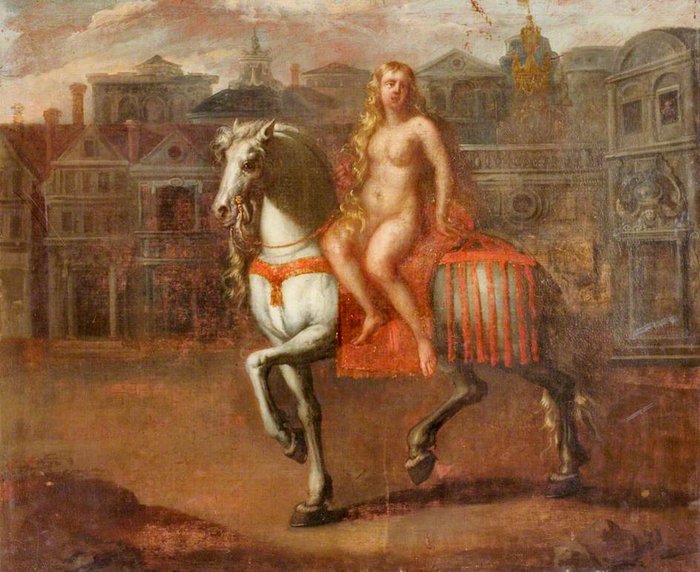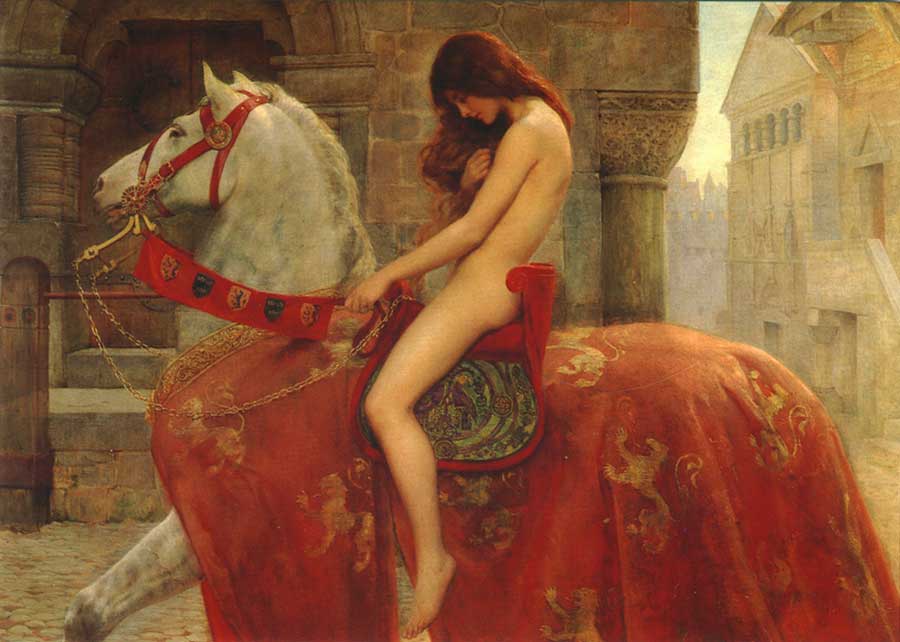
Online collections
monedastodas.com
All collections » Tokens » Coventry Halfpenny
Lady Godiva riding a horse / Armorial bearings of the city of Coventry.
Edge: PAYABLE AT THE WAREHOUSE OF ROBERT REYNOLDS & Co.
Dalton & Hamer: 232.

On the front side of the token is depicted Lady Godiva on horseback and a circular legend: "PRO BONO PUBLICO" (translated from Latin - "For the Common Good"), in the lower part, the year of minting is 1792. Lady Godiva (Eng. Godiva, from Latinized OE Godgyfu, Godgifu - "gifted by God"; 980 - 1067) was the wife of Count Leofric, whose subjects suffered from high taxes. Godiva begged her husband to reduce taxes and one day, being very drunk, Leofric promised to reduce taxes if she rode a horse through the streets of Coventry naked. He was sure that she would not agree, but Godiva put the people above her own honor and agreed.
 Lady
Godiva, (oil on canvas) by Noort, Adam van (1562-1641); Date: 1586; Dimensions:
101.5×123 cms; © Herbert Art Gallery & Museum, Coventry, UK / Bridgeman Images
Lady
Godiva, (oil on canvas) by Noort, Adam van (1562-1641); Date: 1586; Dimensions:
101.5×123 cms; © Herbert Art Gallery & Museum, Coventry, UK / Bridgeman ImagesOn the appointed day, the inhabitants of the city, in respect for her kindness, closed the shutters and doors of their houses, no one went out into the street, and Godiva drove through the whole city unnoticed. Count Leofric had to cut taxes. This legend is not supported by any facts. During the reign of Edward the Confessor (c. 1003 - 1066) in 1043 Earl Leofric built a Benedictine monastery in Coventry, which turned Coventry from a small settlement into the fourth largest medieval English city. The earl endowed the monastery with land and gave possession of 24 villages, and Lady Godiva donated a large amount of gold, silver and precious stones, making the monastery the richest in England. Being very pious, after the death of the count, Godiva transferred all his possessions to the church. Count Leofric and Lady Godiva were buried in this monastery. The first mention of a naked horsewoman was spread by the envious of fame and fortune Roger Wendrover, a monk of the monastery of St. Alban, in 1188. Subsequently, the legend was overgrown with new events. One of these additions is the peeping Tom, who decided to look out of the window at the naked horsewoman and immediately went blind. In fact, in 1586, the city council of Coventry commissioned the artist Adam van Noort (1562-1641) to depict the legend of Lady Godiva in a painting. The population took Leofric, depicted in the picture, looking out the window, for a disobedient citizen. Despite the lack of evidence of the described events, the legend of Lady Godiva has firmly entered the life of the city of Coventry, and since 1678 this event has been annually celebrated with a colorful festival.
 Lady
Godiva by John Koller, 1898
Lady
Godiva by John Koller, 1898The reverse side shows a fragment of the coat of arms of the city of Coventry (Elephant with a castle on its back) and a circular legend: "COVENTRY HALFPENNY".
Edge lettering: "PAYABLE AT THE WAREHOUSE OF ROBERT REYNOLDS & Co" (Payable at Robert Reynolds Warehouse). The weaver Robert Reynolds was engaged in the production of textile ribbons in Coventry.
Stamp engraver - Minewaring, manufacturer - Latvich.
The design of the tokens is quite ordinary. The elephant has a sad and decadent appearance and is more like a soft toy; while the front leg of the horse appears to be wooden, on some specimens Lady Godiva's toes are missing or too long.